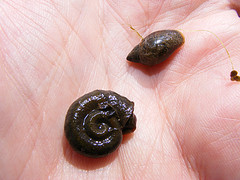A Snail's Pace

June 2010
What animal is more humble than a snail? They are the epitome of slowness. The dull-colored shells are easily overlooked within the lake and rarely studied, but snails are a source of food for 20% of freshwater fish species including sunfish and perch. There are approximately 650 species of freshwater snails in North America inhabiting environs from the Arctic Circle to the Everglades, including our own Lake Champlain.
Snails share the phylum Mollusca with clams, mussels, squids, and octopi. Within that phylum they occupy the class Gastropoda, meaning ‘stomach-foot’. Their body has three parts. A smallish head sits atop a large muscular ‘foot’ which they use for locomotion. When the animal is active the foot and head sit outside the shell, but both can be retracted into the shell. The internal organs are recessed and attached to the inside of the shell.
Snails’ shells provide some identifying characters as to species or genus. A snail’s shell is comprised principally of layers of calcium carbonate laid down in sheets over a thin organic matrix. The need for calcium carbonate means large numbers of snails can often be found on concrete structures like bridge abutments, where the concrete offers a source of calcium. The outside shell layer is a horn-like protein material. Shells may be helical or spiral; flattened or egg-shaped. One key to identification is whether the opening of the shell is to the right (dextral) or to the left (sinistral – from the same word root as sinister, an association to which my left-handed wife takes umbrage). However, for many species, careful examination of soft body parts is necessary for species identification.
Collectors use menthol crystals to relax the bodies of specimens before preserving them in ethyl alcohol. The menthol knocks them out so the bodies don’t withdraw into the shell before preservation. The Freshwater Snails of New York notes that if crystals are not available, “tobacco from menthol cigarettes also will act as a narcotizing agent”. Cigarettes and booze? One wonders if the choice of preservatives came about after careful trial and error, or by taking advantage of early collectors most readily available field provisions.
Locomotion can be challenging for a small animal with no backbone and a heavy shell. To move, snails exude a slime over which they can walk with their muscular foot. The slime provides a sticky surface to which the foot adheres. In fact, the ability of snail slime to stick tenaciously to even wet surfaces has intrigued engineers trying to build better glues. Researchers at Ithaca College in New York have been studying snail slime in the hopes that it can help them identify new surgical glues.
Snail slime adheres to not just hard wet surfaces like rocks and bridge abutments, but also to water itself. Snails can actually attach themselves to the underside of water’s surface film and propel themselves forward; all the while feeding on the detritus and algae along the surface just as they would along the glass in a fish tank. They vary the thickness and texture of the slime trail by creating ripples in their foot as they lay it down. The varied texture allows the snails to propel themselves forward.
Snails’ ability to walk under the water surface is common enough that some species of flies have evolved to find them there and parasitize them. There is an entire order of flies, the Sciomyzidae, adapted to feeding on snails. The larvae of these flies parasitize, prey upon, or scavenge snails. According to Freshwater Molluscs by Robert Dillon some of these larvae, “have gut air-bubbles and hang from the surface film” by tufts of hair that repel water. “They sink their mouth hooks into the exposed foot of any snail they may encounter.” A single larva can eat up to a dozen snails.
Snails may be among the most unglamorous creatures. Yet poet John Donne felt they offered a lesson that all should heed: “And seeing the snail, which everywhere doth roam, Carrying his own house still, still is at home, Follow (for he is easy paced) this snail, Be thine own palace, or the world's thy gaol.”
Lake Look is a monthly natural history column produced by the Lake Champlain Committee (LCC). Formed in 1963, LCC is the only bi-state organization solely dedicated to protecting Lake Champlain’s health and accessibility. LCC uses science-based advocacy, education, and collaborative action to protect and restore water quality, safeguard natural habitats, foster stewardship, and ensure recreational access.
Get involved by joining LCC using our website secure form (at www.lakechamplaincommittee.org), or mail your contribution (Lake Champlain Committee, 208 Flynn Avenue - BLDG 3 - STUDIO 3-F, Burlington, VT 05401), or contact us at (802) 658-1414, or lcc@lakechamplaincommittee.org for more information.
